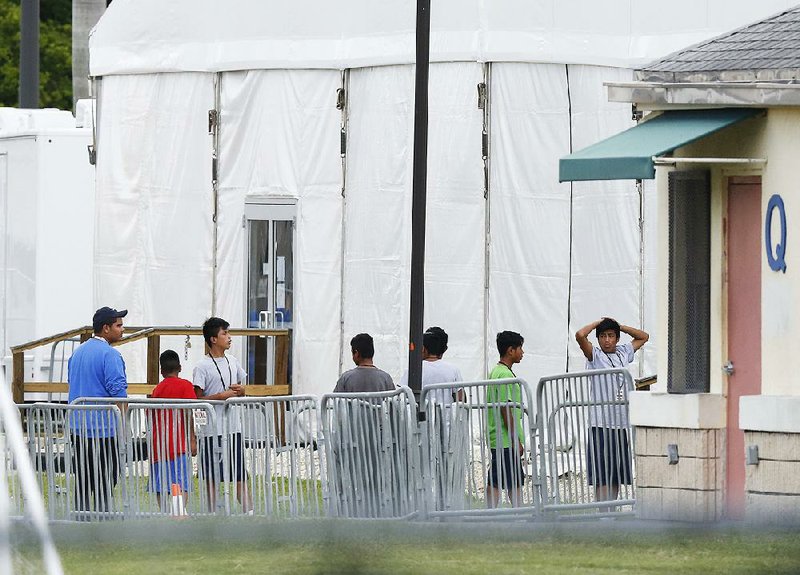HOUSTON -- President Donald Trump's administration likely separated thousands more children from their parents at the southern border than was previously believed, according to a report by government inspectors released Thursday.
The federal government has reported that nearly 3,000 children were forcibly separated from their parents under last year's "zero-tolerance" immigration policy under which nearly all adults entering the country illegally were prosecuted, and any children accompanying them were put into shelters or foster care.
Even before the administration officially unveiled the zero-tolerance policy in the spring of 2018, the U.S. Department of Health and Human Services, the agency that oversees the care of children in federal custody, had noted a "sharp increase" in the number of children separated from a parent or guardian, according to the report from the agency's Office of Inspector General.
As of December, the department had identified 2,737 children who were separated from their parents under the policy and required to be reunified by a federal court order issued in June.
But that number does not represent the full scope of family separations. Thousands of children may have been separated during an influx that began in 2017, before the accounting required by the court, the report said.
Thus, the total number of children separated from a parent or guardian by immigration authorities is "unknown," because of the lack of a coordinated formal tracking system between the Office of Refugee Resettlement, the arm of Health and Human Services that takes in the children, and the Department of Homeland Security, which separated them from their parents.
"This report confirms what we suspected: This cruel family separation practice was way bigger than the administration let on," said Lee Gelernt, who challenged the policy in court on behalf of the American Civil Liberties Union. "We will be back in court and ask the judge to order the government to explain these numbers," he said.
The family separations were a key part of the Trump administration's effort to deter migrant families from trying to enter the country at the Southwest border, where they have arrived in large numbers, most of them fleeing violence and deep poverty in Central America.
While the policy was framed as a decision to prosecute those who entered the United States illegally, it resulted in thousands of parents spending months in agonized uncertainty, unable to communicate with their children and in many cases not knowing even where the children were.
Infants and toddlers were among the children who were put into foster homes or children's shelters, often hundreds or thousands of miles away from where their parents were detained. Under separate policies, the administration also made it difficult for relatives other than the children's parents to take the children into their homes.
After a review of internal government tallies, The New York Times found last year that more than 700 children had been separated from their families in the months before the government officially announced the zero-tolerance policy.
On June 26, a federal judge in San Diego, in response to the ACLU lawsuit, directed the federal government to halt the separations at the border and to reunite children with their parents. Trump rescinded the policy that same month.
However, the federal inspectors found that separations have continued to occur: As of November, the report found, Health and Human Services had received at least 118 children who had been separated from their families since the court order.
Officials at the Department of Homeland Security, which oversaw the family separations at the border, have said they have separated families only when necessary, such as when a parent is facing a serious criminal prosecution, or when authorities have reason to believe that the adult accompanying the child is not an appropriate guardian.
"The report vindicates what [the Department of Homeland Security] has long been saying," said Katie Waldman, a spokesman for the department. "For more than a decade it was, and continues to be, standard for apprehended minors to be separated when the adult is not the parent or legal guardian, the child's safety is at risk, or serious criminal activity by the adult. We are required under the law that Congress passed to send all unaccompanied alien children to [the Health and Human Services Department]."
Ann Maxwell, the Health and Human Services Department's assistant inspector general for evaluation and inspections, said the separations appeared to have been occurring for a full year before the court issued its order.
"Thousands of children were separated from parents and guardians, referred to [Health and Human Services] and released from [the department's] care before the court order," Maxwell said in a conference call with reporters.
"The total number is unknown," she said. "It is certainly more than 2,737, but how many more, precisely, is unknown." Moreover, that number may never be known: Department officials, she said, had told her office that there were "no efforts underway to identify that. It would take away resources from children already in care."
In an email after the call, Maxwell's spokesman confirmed that inspectors believed the number of separated children may be "thousands" more than the 2,737 reported to the court.
A Section on 01/18/2019
